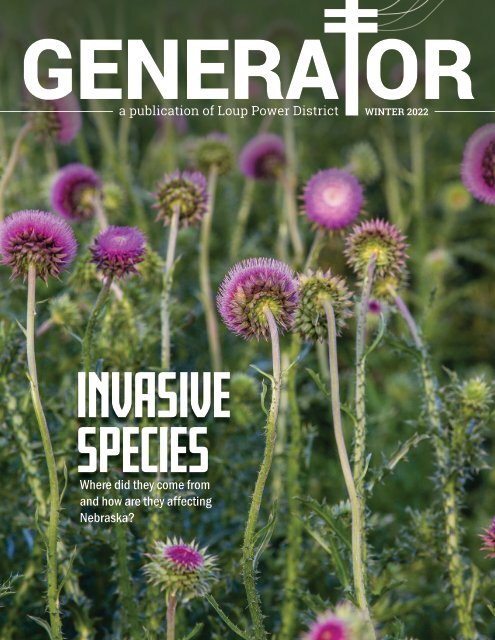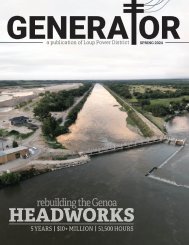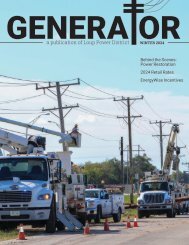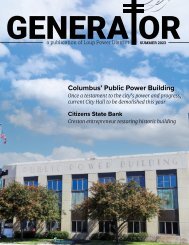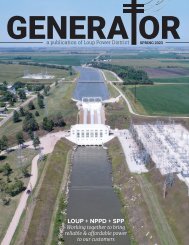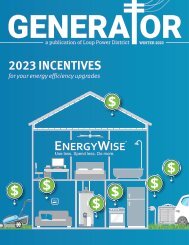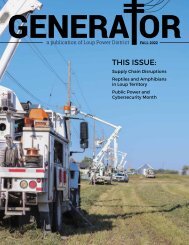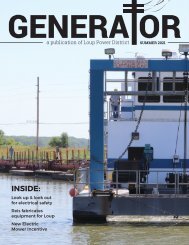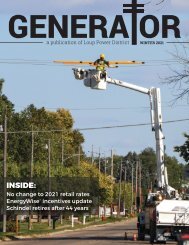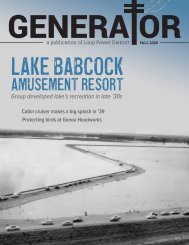Loup Generator — Winter 2022
Learn more about the invasive species in Nebraska and what you can do if you spot them. The 2022 list of financial incentives available to customers who make energy-efficient upgrades. Also in this issue, Mini-Splits 101: an introduction for homeowners.
Learn more about the invasive species in Nebraska and what you can do if you spot them. The 2022 list of financial incentives available to customers who make energy-efficient upgrades. Also in this issue, Mini-Splits 101: an introduction for homeowners.
You also want an ePaper? Increase the reach of your titles
YUMPU automatically turns print PDFs into web optimized ePapers that Google loves.
GENERA OR<br />
a publication of <strong>Loup</strong> Power District WINTER <strong>2022</strong><br />
INVASIVE<br />
SPECIES<br />
Where did they come from<br />
and how are they affecting<br />
Nebraska?
BOARD OF DIRECTORS<br />
Ross Knott<br />
Chairman<br />
Alan Drozd<br />
First Vice Chairman<br />
Steve Heesacker<br />
Second Vice Chairman<br />
Robert Cerv<br />
Secretary<br />
Dick Tooley<br />
Treasurer<br />
Rich Aerni<br />
Jim Donoghue<br />
Mike Fleming<br />
Chris Langemeier<br />
Larry Zach<br />
HOW DO WE SET<br />
ELECTRICITY RATES?<br />
<strong>Loup</strong> Power District identifies electricity rates based on cost of service<br />
while keeping our customers and our communities front and center. As a<br />
not-for-profit company, <strong>Loup</strong> does not answer to remote shareholders and<br />
is not driven by a profit motive. Revenues are invested right back into the<br />
company and communities.<br />
EXECUTIVE STAFF<br />
Neal Suess<br />
President/CEO<br />
Walt Williams<br />
Vice President,<br />
Accounting & Finance/CFO<br />
Todd Duren<br />
Vice President,<br />
Corporate Services<br />
Korey Hobza<br />
Vice President, Engineering<br />
Dan Hellbusch<br />
Vice President, Operations<br />
The <strong>Loup</strong> <strong>Generator</strong> is<br />
published quarterly<br />
as a service for <strong>Loup</strong><br />
employees, families,<br />
friends, and associates.<br />
For feedback, story ideas<br />
and submissions, contact:<br />
Stacy Wemhoff<br />
Communications Coordinator<br />
402-562-5711<br />
swemhoff@loup.com<br />
ADD UP ALL THE COSTS. <strong>Loup</strong> conducts a cost-of-service study to<br />
determine the revenue requirement <strong>—</strong> how much revenue is required<br />
to maintain financial stability. The costs are separated into three areas:<br />
power supply and transmission, distribution, and customers.<br />
DIVIDE REVENUE REQUIREMENTS by customer class <strong>—</strong> commercial,<br />
industrial, residential. The cost-of-service study identifies how and when<br />
each class uses energy, and how the utility incurs costs from each class.<br />
The study identifies the amount to recover through customer, demand,<br />
and energy charges for each customer class, and how costs vary by time of<br />
day or season. This amount is then compared with the rates for each class.<br />
FACTOR a rate adjustment strategy into a financial plan. The plan takes input<br />
from management and the Board of Directors and lays out a strategy for<br />
how rates should be implemented in the future. The plan ensures adequate<br />
revenues are recovered for each class of customer and explains how each<br />
rate component (customer, energy, demand) should vary over time.<br />
BALANCE the recommended rates with the governing body’s input and<br />
community objectives. <strong>Loup</strong>’s managers present the rate study to the Board<br />
of Directors. The Board decides whether the proposed rate structure meets<br />
the needs of the community and the utility’s revenue requirements.<br />
FINAL RATE. The newly set rates go into effect on<br />
customers’ monthly bills. <strong>Loup</strong>’s residential rates have<br />
not changed since 2018.<br />
2 | GENERATOR<br />
COVER PHOTO: Musk thistles. Photo by Nebraskaland Magazine/Nebraska Game and Parks Commission.
president’s message<br />
<strong>Loup</strong> working to bring<br />
broadband to rural areas<br />
Over the past several months, many of you have<br />
possibly read the articles linking <strong>Loup</strong> Power<br />
District to studies associated with rural broadband.<br />
After thinking about this for a while, you<br />
might ask yourself, “Why is <strong>Loup</strong> doing this, and<br />
what is the benefit?”<br />
To start, there is a substantial amount of money<br />
available from various government resources<br />
to bring high speed broadband access to rural<br />
areas of the country. That funding prompted us<br />
to consider how we could assist with this effort.<br />
So, <strong>Loup</strong>, Nebraska Public Power District (NPPD),<br />
Platte County, and Cornhusker Public Power<br />
District worked together to enlist the services of the<br />
National Rural Telecommunications Cooperative.<br />
The NRTC <strong>—</strong> which serves more than 1,500 utilities<br />
in 48 states <strong>—</strong> is conducting a study on bringing<br />
high speed broadband service to <strong>Loup</strong>’s fourcounty<br />
area.<br />
<strong>Loup</strong> and NPPD have been discussing how access<br />
to high speed broadband can help with economic<br />
development in the rural areas of <strong>Loup</strong>’s service<br />
area. NPPD has been looking at numerous precision<br />
agricultural developments, and this type of<br />
service could enhance that activity, as well as other<br />
economic development services. Additionally,<br />
high speed broadband might entice some young<br />
adults to stay in our smaller towns rather than<br />
migrating to larger cities in the Midwest.<br />
As you can see, the benefit is real and tangible <strong>—</strong><br />
especially if this can be done in the right manner.<br />
One impediment to this, however, is a State of<br />
Nebraska law that prohibits <strong>Loup</strong> from providing<br />
broadband service to end-use customers. State law<br />
does not, however, prohibit <strong>Loup</strong> from developing<br />
a backbone for service that can be leased<br />
to a company that provides the service. <strong>Loup</strong> has<br />
a vast amount of infrastructure (such as power<br />
poles) already in place that can be used to string<br />
fiber optic cable that can be used for high speed<br />
broadband service.<br />
This process draws similarities to the electrification<br />
of rural Nebraska in the 1930s and ’40s. The<br />
foresight for stringing wire to rural America along<br />
with federal programs helped bring electricity to<br />
area homes. This enhanced the quality of life for<br />
everyone in the rural areas of the United States.<br />
Broadband can have the same effect on rural<br />
residents today.<br />
With the Covid-19 pandemic of the past 18 months,<br />
it has become even more important to bring<br />
high speed broadband access to the rural areas<br />
of Nebraska. It is imperative that schools and<br />
students have this access in the event that they<br />
need to conduct remote learning.<br />
All these factors persuaded <strong>Loup</strong> Power District’s<br />
Board of Directors and management that this<br />
project was worth pursuing. It is definitely not a<br />
done deal, but at least the process has started,<br />
allowing the District to better determine the project’s<br />
feasibility and economics.<br />
As we move forward, you can keep up to date by<br />
following <strong>Loup</strong> on social media, looking at our<br />
website, and watching the news. We look forward<br />
to it.<br />
NEAL SUESS<br />
President/CEO<br />
WINTER <strong>2022</strong> | 3
are you<br />
Check out these energy-saving incentives!<br />
Smart Thermostat Program<br />
If you have a home Wi-Fi connection and a central<br />
air-conditioning or heat pump system, you<br />
may qualify for an incentive of up to $100 for a<br />
qualifying smart thermostat.<br />
Smart thermostat technology is most beneficial<br />
for households that have extended periods during<br />
the day when no one is home. It is also a great<br />
option for homes that have irregular occupancy<br />
through the week, month or year.<br />
Attic Insulation<br />
Residential customers who have 6"<br />
or less of attic insulation and electric<br />
heating systems are eligible for an<br />
incentive of 15¢ per square foot if they<br />
add at least 6" (or an additional R-19)<br />
of insulation to their attic space.<br />
The maximum incentive amount is $300<br />
per dwelling.<br />
SYSTEM TYPE<br />
INCENTIVE<br />
Primarily Electric Heat (Professionally Installed) $100<br />
Primarily Electric Heat (Customer Installed) up to $75<br />
Primarily Fossil-Fuel Heat (Professionally Installed) $50<br />
Primarily Fossil-Fuel Heat (Customer Installed) up to $25<br />
Induction Cooktop<br />
The Induction Cooking Program<br />
offers a 20% incentive to those<br />
who purchase an induction<br />
cooktop or range with a minimum<br />
width of 30".<br />
Electric Vehicle & Charging Station<br />
• $4,000 for the purchase of a new electric vehicle<br />
• $500 for installation of a residential ChargePoint 32-amp, Wi-Fi-enabled vehicle<br />
charging station.<br />
• Up to $400 for in-home pre-wiring for future installation of an electric vehicle<br />
charging station.<br />
• Commercial Conduit <strong>—</strong> 100% reimbursement incentive (maximum of $1,000)<br />
for new commercial construction for the installation of conduit to be used for a<br />
future public electric vehicle charging station.<br />
• Commercial Charger <strong>—</strong> 50% reimbursement<br />
incentive for eligible costs for the<br />
installation of an electric vehicle<br />
public charging station.<br />
4 | GENERATOR
High Efficiency Heat Pumps<br />
Option 1: Direct incentive<br />
SYSTEM TYPE CRITERIA INCENTIVE<br />
Ductless Mini-Split 15+ SEER, 12.5 EER, 8.5 HSPF $400<br />
Ductless Mini-Split<br />
Air Source<br />
Air Source<br />
Variable Capacity (inverter<br />
driven)<br />
15-15.9 SEER, 12.5 EER, 8.5<br />
HSPF<br />
16-17.9 SEER, 12.5 EER,<br />
8.5 HSPF<br />
$600<br />
$400<br />
$800<br />
Air Source 18+ SEER, 12.5 EER, 8.5 HSPF $1,200<br />
Air Source Variable Capacity $1,200<br />
Ductless Mini Splits<br />
(Multi Heads, 3 ton or greater)<br />
Geothermal <strong>—</strong> water-to-air<br />
or water-to-water<br />
{1 or 2 stages)<br />
Geothermal <strong>—</strong> water-to-air<br />
or water-to-water<br />
(Variable capacity)<br />
Option 2: Low-Interest Loan Program<br />
Variable Capacity (inverter<br />
driven)<br />
$1,200<br />
Any EER $2,400<br />
35+ EER, 5.0+ COP in GLHP -<br />
partial load column of AHRI<br />
or Energy Star certificate<br />
$3,300<br />
You can finance your new heat pump system at a low interest rate<br />
through a partnership with the Nebraska Energy Office and about 600<br />
financial institutions throughout the state as an alternative to a direct<br />
incentive.<br />
Customers cannot proceed with the installation until the Nebraska Energy<br />
Office has processed the loan paperwork (this can take as many as 10<br />
business days). Homes built within the last five years are ineligible for the<br />
loan, but owners can apply for the incentive.<br />
Electric Lawn Mower<br />
Advances in battery technology have come<br />
a long way in recent years.<br />
More power is being packed into batteries<br />
so your mower can speedily deliver a<br />
knock-out punch to your lawn.<br />
• 20% incentive on any new batterypowered<br />
or corded electric lawn mower.<br />
• Electric riding, walk-behind, and robotic<br />
mowers are eligible.<br />
• Incentive amount is based on purchase<br />
price (installation, taxes, delivery/<br />
shipping, and setup costs are NOT<br />
eligible).<br />
• Chargers and additional battery<br />
purchases are eligible for the incentive<br />
if they are purchased at the same time<br />
as the mower.<br />
Heat Pump Water Heater<br />
SYSTEM TYPE CRITERIA INCENTIVE<br />
Air Source Heat Pump Water Heater EF > 1.9 $400<br />
Water or Ground Source<br />
Heat Pump Water Heater<br />
COP > 2.8 $650<br />
Cooling System Tune Up<br />
Residential customers are eligible for a<br />
$30 yearly incentive when they have their<br />
cooling system tuned up by an HVAC<br />
contractor.<br />
Air conditioners and heat pumps are<br />
eligible.<br />
Industrial & Agricultural Incentives<br />
Industrial customers can receive incentives for a variety<br />
of energy-saving projects including prescriptive and<br />
custom lighting, commercial HVAC and HVAC system<br />
optimization, industrial processes, variable frequency drives,<br />
and heat pump water heaters.<br />
Incentives are available to ag customers who replace<br />
irrigation outlet components or install a corner pivot<br />
VFD. The Custom Agriculture Incentive Program helps<br />
offset the costs of energy efficiency improvements for<br />
unique programs including grain conditioning, animal<br />
husbandry, building upgrades, and more.<br />
Learn more about these<br />
programs at loup.com<br />
or by calling Greg Badstieber<br />
at 402-562-5718.<br />
This program is offered in<br />
partnership with Nebraska<br />
Public Power District.<br />
WINTER <strong>2022</strong> | 5
INVASIVE SPECIES<br />
& their economic and environmental impact<br />
Their colors brighten the prairies and<br />
fields. Vibrant purples and pinks and<br />
yellows. Tall and elegant or uniquely spiked.<br />
Despite their beauty, some of these plants<br />
are aggressive and dangerous, smothering<br />
surrounding vegetation and taking over.<br />
There are some aquatic species that are<br />
harmful, too, threatening Nebraska’s lakes<br />
and rivers.<br />
These species have one thing in common:<br />
they don’t belong here.<br />
“The economic and social impacts of<br />
invasive species include both direct effects<br />
of a species on property values, agricultural<br />
productivity, public utility operations, native<br />
fisheries, tourism, and outdoor recreation,<br />
as well as costs associated with invasive<br />
species control efforts,” according to the<br />
United States Department of Agriculture.<br />
A 2021 study estimated that invasive<br />
species have cost North America more<br />
than $26 billion per year since 2010.<br />
WHAT ARE INVASIVE SPECIES<br />
AND WHERE DID THEY COME FROM?<br />
An invasive species can be any kind of<br />
non-native living organism <strong>—</strong> an amphibian,<br />
plant, insect, fish, fungus, bacteria, or even<br />
an organism’s seeds or eggs.<br />
These species are given the<br />
“invasive” label when they grow<br />
and reproduce quickly, or spread<br />
aggressively, outcompeting<br />
native flora and fauna.<br />
Aquatic Invasive Species are introduced<br />
to new environments in a variety of ways<br />
<strong>—</strong> sometimes intentionally and sometimes<br />
by mistake. Some species, such as common<br />
carp, were introduced intentionally because<br />
immigrants desired them as a food source,<br />
according to the Nebraska Game and Parks<br />
Commission (NE G&PC).<br />
Plant species were often introduced for<br />
landscaping or brought into the country by<br />
immigrants.<br />
The pet trade also introduces new species<br />
unintentionally. Snakehead, Asian clams,<br />
and mystery snails were introduced in the<br />
United States when pet owners disposed of<br />
them in public waters. Exotic species such<br />
as pacu and piranha have been collected in<br />
Nebraska waters, though fortunately neither<br />
species can survive our winters.<br />
Unintentional introduction through<br />
transport accounts for many invasive species<br />
introductions.<br />
These organisms usually hitchhike on<br />
materials shipped from other countries or in<br />
the ballast waters of ships in the Great Lakes<br />
or ports along our coasts.<br />
The Great Lakes have been a major introduction<br />
location for many organisms such as<br />
zebra mussels, quagga mussels, and round<br />
goby, according to the NE G&PC.<br />
LOUP REQUIRED TO MONITOR<br />
AND CONTROL INVASIVE SPECIES<br />
<strong>Loup</strong>’s hydroelectric license from the<br />
Federal Energy Regulatory Commission<br />
(FERC) requires the District to monitor<br />
invasive species throughout its territory.<br />
New Century Environmental (NCE) of<br />
Columbus serves as an environmental<br />
contractor for <strong>Loup</strong>. The company’s<br />
employees complete rigorous surveys to<br />
ensure that invasive species are not<br />
establishing themselves and causing<br />
damage to District infrastructure.<br />
Invasive species could also harm land<br />
conservation efforts. Invasive species can<br />
change community structure, composition,<br />
and ecosystem processes on these lands in<br />
ways that may not be anticipated.<br />
In addition to making sure new species<br />
aren’t making their way into the <strong>Loup</strong> area,<br />
NCE biologists also monitor invasive species<br />
that already established. Careful management<br />
can minimize negative impacts to <strong>Loup</strong><br />
and the land.<br />
Michael Gutzmer, principal of New<br />
Century Environmental, said invasive<br />
species encroachment will be a challenge<br />
for <strong>Loup</strong> and other large landowners in the<br />
coming years. He said agencies and citizens<br />
should realize the benefits <strong>Loup</strong>’s monitoring<br />
efforts provide for the environment.<br />
He said it is no small task to generate<br />
electricity while maintaining environmental<br />
compliance.<br />
“<strong>Loup</strong> Power District has been a reliable<br />
and affordable provider for almost a<br />
century,” he said. “There is no doubt <strong>Loup</strong> is<br />
aware of those new and coming species that<br />
could impact our local natural resources.”<br />
Purple loosestrife<br />
is a common invasive<br />
plant in Nebraska<br />
waterways.<br />
6 | GENERATOR
A new aquatic invasive <strong>—</strong> creeping water primrose (Ludwigia peploides) was<br />
found just off the <strong>Loup</strong> bypass reach in summer 2021. Photo by Michael Gutzmer.<br />
INVASIVE FLORA<br />
Nearly 400 species of non-native<br />
plants now grow in Nebraska. Most<br />
of these do not cause ecological or<br />
economic damage.<br />
Some species, however, are<br />
destructively invasive <strong>—</strong> infesting<br />
native prairies, woodlands, and<br />
wetlands; displacing native vegetation<br />
and degrading wildlife habitat; and<br />
harming cropland, yards, and gardens.<br />
<strong>Loup</strong> has numerous locations with<br />
aquatic species of plants that can be<br />
vulnerable to invasion from non-native<br />
species.<br />
New Century Environmental biologists<br />
have documented more than 200<br />
plant species on <strong>Loup</strong> lands since 2018.<br />
Invasive species in these areas include<br />
leafy spurge, Canada thistle, musk<br />
thistle, reed grass, common buckthorn,<br />
and purple loosestrife.<br />
The primary consequence of<br />
established invasive plants is that<br />
they displace native or more desirable<br />
plant communities. Invasive plants<br />
change the food web in an ecosystem<br />
by destroying or replacing native food<br />
sources. The invasive species may<br />
provide little to no food value for wildlife<br />
or livestock. Invasive species can<br />
also alter the abundance or diversity of<br />
species that are important habitat for<br />
native wildlife.<br />
“The grasslands of the Northern<br />
Great Plains are in the midst of extensive<br />
alteration and redistribution of<br />
important species,” Gutzmer said.<br />
“Invasive plants contribute to the<br />
degradation of these ecosystems and<br />
present monumental challenges for<br />
natural resource managers.”<br />
Widespread decreases in populations<br />
of grassland-dependent wildlife,<br />
particularly birds, have been documented,<br />
he said.<br />
Seth Gutzmer holds a silver carp found<br />
in a <strong>Loup</strong> River bypass backwater.<br />
Special thanks to New Century Environmental<br />
and Michael Gutzmer for information in this<br />
story. The company’s scientists and engineers<br />
assess and manage a variety of compliance<br />
and natural resources issues throughout the<br />
Great Plains.<br />
INVASIVE FAUNA<br />
Aquatic invasive species can cause<br />
lasting damage in water systems. Once<br />
established, these species may introduce<br />
disease, push out native species,<br />
drastically change food chains and<br />
physical characteristics, and damage<br />
equipment and water delivery systems.<br />
Silver carp, an invasive fish species,<br />
are found in the <strong>Loup</strong> canal, the <strong>Loup</strong><br />
River bypass, and the lower Platte River.<br />
Invasive species of concern in<br />
Nebraska include the zebra mussel,<br />
quagga mussels, New Zealand mud<br />
snail, Asian clam, and Chinese mystery<br />
snail. Active monitoring has become<br />
necessary in preventing the spread of<br />
these species and minimizing damage<br />
to our aquatic resources.<br />
Other invasive species of concern<br />
include Eurasian collared-dove, European<br />
starling, house sparrow, and rock<br />
dove. These species are well established<br />
in <strong>Loup</strong>’s service territory and controlling<br />
them would be very difficult. There<br />
is potential for various invasive insects<br />
and feral hogs to become a concern in<br />
the future as well.<br />
stop the spread<br />
Here are some tips to help stop the spread<br />
of invasive species. Keep these in mind<br />
anytime you visit any <strong>Loup</strong> park as well as<br />
state and national parks.<br />
Don’t let it loose! Do not release pets<br />
into the wild or dump aquariums or bait<br />
buckets into waterways. Unused bait<br />
should be discarded into trash cans.<br />
Clean, Drain, Dry. Thoroughly rinse your<br />
gear and pressure wash your boats, skis,<br />
and other recreation vehicles on site.<br />
Plants and aquatic organisms can get<br />
into any place water can get into. Use hot<br />
water if available.<br />
Don’t keep invasive species as pets<br />
and don’t choose invasive species for your<br />
landscaping.<br />
Wash your vehicle, especially if you<br />
have been driving on unpaved roads or off<br />
road. Plant materials can get stuck in your<br />
tires and undercarriage. This includes<br />
cars, bikes, and ATVs.<br />
Shake out your tent, camp chairs,<br />
sleeping bags, and other camp<br />
accessories before leaving the campsite<br />
to remove any plant or seed materials.<br />
Brush off or wash your pets.<br />
Sticky seeds can hitchhike on their fur.<br />
Clean your shoes or boots by knocking<br />
dirt and plant materials out of the treads.<br />
Consider carrying a boot brush in your car<br />
or pack. Rinse the soles if possible.<br />
Don’t move firewood. Use local<br />
firewood. Do not bring in firewood<br />
from outside the immediate area.<br />
<strong>—</strong> from the National Park Service<br />
have you spotted an invasive species?<br />
• Report your sighting at neinvasives.com<br />
• Report aquatic invasive species (AIS)<br />
to the Nebraska Game & Parks Commission<br />
at ngpc.AIS@Nebraska.gov or 402-471-7602<br />
WINTER <strong>2022</strong> | 7
MOST<br />
UNWANTED<br />
INVASIVE SPECIES ON LOUP PROPERTY<br />
CANADA THISTLE<br />
Cirsium arvense<br />
Height: up to 4'<br />
Flowers: June to August<br />
Identification: Irregular, sharply lobed<br />
foliage; margins with short spines;<br />
compound pink to purple flowers<br />
in clusters; smaller than other thistles<br />
Known locations: a wide variety of habitats<br />
<strong>—</strong> rangeland, cropland, roadsides, and<br />
edges of waterways throughout Nebraska<br />
Birthplace: Eurasia and North Africa<br />
Crimes: Spreads up to a half a mile by<br />
wind, water, and wildlife; multi-million<br />
dollar losses in crop production due to<br />
competition; releases toxic substances<br />
into the soil which inhibits growth of some<br />
plants; competes with native vegetation<br />
LEAFY SPURGE<br />
Euphorbia esula<br />
Height: usually 1–2' (can grow to 3')<br />
Flowers: May to September<br />
Identification: Green to yellow bracts<br />
surround non-showy flowers; oblong<br />
leaves with one noteworthy vein; three<br />
lobed capsule fruits<br />
Known locations: Cropland, woodlands,<br />
shelter belts, and rangeland; roadsides<br />
and disturbed sites throughout most<br />
Nebraska counties<br />
Birthplace: Eurasia<br />
Crimes: Spreads by seeds and shoots from<br />
crown and roots; costs millions of dollars<br />
annually due to lost production; toxic to<br />
cattle; establishes quickly and easily and<br />
out-competes native vegetation<br />
MUSK THISTLE<br />
Carduus nutans<br />
Height: 10'<br />
Flowers: May to August<br />
Alias: Nodding Thistle<br />
Identification: Compound pink-purple<br />
flowers; serrated leaves; white spines at<br />
the end of each lobe<br />
Known locations: Widespread in most<br />
Nebraska counties<br />
Birthplace: Eurasia and North Africa<br />
Crimes: Prolific seed production; forms<br />
dense colonies that reduce yield in forage<br />
crops; competes with native vegetation<br />
INVASIVE CARP<br />
Birthplace: China & Eastern Asia;<br />
brought to Arkansas aquaculture<br />
farms in the 1970s<br />
Through flooding and accidental releases, black, grass,<br />
bighead and silver carps found their way into the Mississippi<br />
River system. This gave them access to many of the<br />
country’s rivers and streams.<br />
Silver Carp<br />
Grass Carp<br />
8 | GENERATOR
PURPLE<br />
LOOSESTRIFE<br />
Lythrum salicaria<br />
Height: up to 8'<br />
Blooms: July through September<br />
Identification: Pink-purple flowers; heartshaped<br />
leaves<br />
Known locations: Widespread throughout<br />
Nebraska, especially in the east along the<br />
Platte and Niobrara Rivers<br />
Birthplace: Introduced from Europe as an<br />
ornamental for landscaping<br />
Crimes: Spreads by resprouting from stem<br />
cuttings and pieces of root stock; longliving<br />
seeds disperse by wind and water,<br />
and can adhere to wildlife, livestock,<br />
people, tires, boats, etc.; forms dense<br />
stands over very large areas, restricting<br />
water movement, trapping sediment and<br />
causing changes in water quality; adapts<br />
to many environments and competes with<br />
native vegetation<br />
PLUMELESS<br />
THISTLE<br />
Carduus acanthoides<br />
Height: up to 4'<br />
Flowers: June to August<br />
Identification: Purple clustered<br />
or solitary flowers; spiny stem (unlike<br />
musk thistle which has a spineless stem<br />
area); spiny leaves; hairs at the tip<br />
Known locations: Widespread in pastures,<br />
rangeland, non-crop areas, and roadsides<br />
<strong>—</strong> especially in Northeast Nebraska<br />
Birthplace: Eurasia<br />
Crimes: Serves as a food source for butterflies<br />
and songbirds; spreads primarily by<br />
wind-driven seed distribution; thousands<br />
of dollars lost in Nebraska agricultural<br />
production annually; competes with native<br />
vegetation<br />
COMMON REED<br />
GRASS<br />
Phragmites australis<br />
Height: up to 20'<br />
Seeds: July through September<br />
Identification: yellow-green leaves<br />
contrast with gray-green foliage of many<br />
native reed grasses<br />
Known locations: Marshes, floodplains,<br />
ditches, ponds, waterways throughout<br />
Nebraska, especially along the Platte River<br />
Birthplace: Introduced from Europe for<br />
erosion control<br />
Crimes: Spreads by extensive rhizomes<br />
and seed dispersal; inadvertently transported<br />
by boats and other recreational<br />
equipment such as duck blinds and<br />
decoys; forms dense stands over very<br />
large areas, restricting water movement,<br />
trapping sediment and causing changes<br />
in water quality; severe infestations<br />
will dominate waters; adapts to many<br />
environments and competes with native<br />
vegetation<br />
Bighead Carp<br />
Crimes: These invasive carp are aggressive,<br />
fast-growing, and prolific feeders that<br />
out-compete native fish and leave a trail<br />
of environmental destruction in their wake<br />
Black Carp<br />
For more information about invasive<br />
carp, visit neinvasives.com and<br />
outdoor nebraska.gov.<br />
Fish photos by Ryan Hagerty/USFWS.<br />
Thanks to MIke Gutzmer for information.<br />
WINTER <strong>2022</strong> | 9
Ductless Mini-Splits 101:<br />
an introduction for homeowners<br />
Keeping your home at a comfortable temperature<br />
can be expensive. A typical household’s energy bill<br />
is around $1,900 annually, and almost half of that<br />
goes to heating and cooling!<br />
To cut these costs, an increasingly popular and<br />
highly versatile system called a mini-split heat<br />
pump can be professionally installed to comfortably<br />
heat and cool your home.<br />
Mini-split heat pumps that earn the ENERGY STAR<br />
label are independently certified to save energy,<br />
save money, and protect the climate.<br />
WHAT IS A MINI-SPLIT HEAT PUMP?<br />
Ductless heat pumps, or mini-split heat pumps, are<br />
an alternative to radiator or baseboard heating, as<br />
well as a replacement for window units for cooling.<br />
No duct work is needed.<br />
Instead, a head unit (or multiple head units),<br />
are mounted on an interior wall or ceiling, with<br />
an accompanying unit outside. The outside unit<br />
extracts heat from the air, even when it’s cold.<br />
Refrigerant carries the heat directly to the head(s)<br />
inside, which then delivers heated air to a space.<br />
In warmer months, the system works in reverse for<br />
efficient air conditioning.<br />
indoor unit<br />
refrigerant lines<br />
outdoor unit<br />
10 | GENERATOR<br />
Graphic courtesy of Mitsubishi Electric
BENEFTS OF A MINI-SPLIT HEAT PUMP<br />
• Cut heating costs in half compared to conventional<br />
electric heating systems. Because they transfer rather<br />
than generate heat, ENERGY STAR certified mini-splits<br />
use up to 60% less energy than standard home electric<br />
radiators.<br />
• Provide quiet, high-efficiency cooling. ENERGY STAR<br />
certified mini-splits use more sophisticated compressors<br />
and fans that can adjust speeds to save energy and<br />
money. They also cool directly from the unit, rather<br />
than passing through a network of fabricated ductwork.<br />
This eliminates energy losses from ductwork which can<br />
account for more than 30% of a home’s energy use for<br />
space conditioning.<br />
• Reducing greenhouse gas emissions. A mini-split is good<br />
for your home and good for the planet. ENERGY STAR<br />
certified systems used in a whole house setting avoid<br />
more than 4,500 pounds of greenhouse gas emissions,<br />
on average, over the course of their lifespan compared to<br />
standard systems.<br />
• Heating and cooling in one device. Mini-split heat pumps<br />
offer highly efficient heating and cooling in one integrated<br />
system.<br />
• Easy, ductwork-free installation. Mini-splits use narrow<br />
refrigerant lines positioned outside your home to deliver<br />
heating and cooling instead of conventional central<br />
heating and cooling which requires bulky <strong>—</strong> and often<br />
expensive <strong>—</strong> ductwork. A small, three-inch hole in an<br />
outdoor wall is all that is needed for the refrigeration lines<br />
to connect the outdoor unit to the indoor unit.<br />
• Custom comfort anywhere in your home. Mini-splits can<br />
maintain different customized temperatures in each room<br />
through control consoles (either wall-mounted or ceilinginserted),<br />
remote controls, and smart phone apps.<br />
DISADVANTAGES<br />
The primary disadvantage of mini-splits is their cost. Such<br />
systems cost about $1,500 to $2,000 per ton (12,000 Btu<br />
per hour) of cooling capacity. This is about 30% more than<br />
central systems (not including ductwork) and may cost twice<br />
as much as window units of similar capacity.<br />
The installer must also correctly size each indoor unit and<br />
judge the best location for its installation. Oversized or<br />
incorrectly located air-handlers often result in short-cycling,<br />
which wastes energy and does not provide proper temperature<br />
or humidity control. A system that is too large is also<br />
more expensive to buy and operate.<br />
Some people may not like the appearance of the indoor part<br />
of the system. While less obtrusive than a window room air<br />
conditioner, they seldom have the built-in look of a central<br />
system. There must also be a place to drain condensate<br />
water near the outdoor unit.<br />
IS A MINI-SPLIT HEAT PUMP RIGHT FOR YOU?<br />
Mini-splits are often used in the following situations:<br />
• Homes with costly electric heat (e.g., baseboard, furnace,<br />
wall heaters, electric radiant) that will also benefit from<br />
cooling.<br />
• Older homes with no existing ductwork (e.g., radiators<br />
or baseboard heat) that have never had central air<br />
conditioning before.<br />
• Existing homes with high fuel costs.<br />
• Additions or outbuildings (e.g., shed, barn, garage)<br />
where extending ductwork or heating/cooling capacity is<br />
difficult.<br />
• Spaces adjacent to unconditioned spaces where ductwork<br />
would be exposed to harsher temperatures (e.g., a guest<br />
room above a garage).<br />
• New high-efficiency homes, including ENERGY STAR<br />
certified homes.<br />
• Older commercial buildings with no existing ductwork for<br />
air conditioning or expansions.<br />
• Where hot or cold spots exist within homes including<br />
spaces which serve as home offices.<br />
Mini-splits come in a variety of styles to meet the unique<br />
heating and cooling applications and customer preferences<br />
to provide efficient comfort that traditional systems cannot<br />
provide. Styles include wall mounts, floor mounts, ceiling<br />
cassettes, and ducted options that can be concealed.<br />
Check out the ENERGY STAR Heating and Cooling Guide at<br />
energystar.gov/HVACguide to see if a mini-split is right<br />
for you. Learn the symptoms of aging heating and cooling<br />
equipment and find product and rebate information.<br />
TAKE ADVANTAGE OF INCENTIVES<br />
<strong>Loup</strong> customers are eligible for a direct incentive of $400<br />
to $1,200 when they install qualifying ductless mini-split<br />
systems.<br />
As an alternative to the direct incentive, customers can<br />
apply for a low-interest loan to purchase a mini-split system.<br />
Nebraska Dollar and Energy Saving Loans are offered<br />
statewide by the Nebraska Department of Environment and<br />
Energy (NDEE) and the state’s lending institutions. (New<br />
homes are eligible for the incentive, but not the loan).<br />
To learn more about these incentives and qualifications,<br />
visit bit.ly/EW-<strong>Loup</strong><br />
Source: U.S. Environmental Protection Agency,<br />
ENERGY STAR program; energy.gov.<br />
WINTER <strong>2022</strong> | 11
No change to <strong>2022</strong> retail rates<br />
Retail rates for <strong>Loup</strong> Power District’s<br />
retail customers will remain the same in<br />
<strong>2022</strong> for the fifth consecutive year.<br />
The <strong>Loup</strong> Power District Board of Directors<br />
reviewed current rate levels as well<br />
as budgeted revenue and expenses at<br />
the November and December board<br />
meetings. This also included a review of<br />
a retail cost of service study performed<br />
by management.<br />
As part of this review, the board<br />
analyzed the purchased power costs<br />
from Nebraska Public Power District<br />
(NPPD), the District’s wholesale power<br />
supplier.<br />
NPPD’s overall costs to <strong>Loup</strong> are not<br />
expected to change for <strong>2022</strong>, even<br />
though some wholesale rates did<br />
change between the summer and winter<br />
season. Therefore, the District’s Board<br />
of Directors felt there was no need to<br />
change retail rates at this time.<br />
“Prior to the recent run of consistent<br />
retail rates, the District has reacted<br />
to changes in wholesale power and<br />
operational costs by making changes<br />
to the retail rates,” said Jim Donoghue,<br />
chairman of <strong>Loup</strong>’s Rates Committee.<br />
“However, the District Board has<br />
worked with management to keep retail<br />
rate levels steady, even given the effects<br />
of the damages from the 2019 storm to<br />
the District’s hydroelectric system and<br />
the impact of the COVID-19 pandemic<br />
on District customers in 2020 and 2021.”<br />
Donoghue added that <strong>Loup</strong>’s board<br />
has implemented a long-term strategy<br />
to maintain its reserve margin at<br />
reasonable levels and keep retail rates<br />
competitive.<br />
<strong>Loup</strong> Power District’s overall rates are<br />
24.8 percent below the national average<br />
and 8.1 percent below the Nebraska<br />
average based on data from a 2020<br />
American Public Power Association<br />
survey.<br />
“<strong>Loup</strong>’s rates remain among the lowest<br />
in Nebraska and the nation,” said <strong>Loup</strong><br />
Board Chairman Ross Knott.<br />
Average Prices for Residential Electricity<br />
2020 figures, in cents per kWh<br />
CA<br />
20.5¢<br />
WA<br />
9.9¢<br />
OR<br />
11.2¢<br />
NV<br />
11.3¢<br />
AK<br />
22.6¢<br />
ID<br />
10¢<br />
UT<br />
10.4¢<br />
AZ<br />
12.3¢<br />
MT<br />
11.2¢<br />
WY<br />
11.1¢<br />
CO<br />
12.4¢<br />
NM<br />
12.9¢<br />
HI<br />
30.3¢<br />
Overall, <strong>Loup</strong> Power District’s rates are<br />
in the lowest tenth percentile both statewide<br />
and nationally.<br />
Energy or kilowatt-hour (kWh) usage<br />
is always the determining factor in a<br />
customer’s bill.<br />
Customers in all rate classifications<br />
continue to have opportunities to<br />
reduce their costs by taking advantage<br />
of numerous programs offered by the<br />
District.<br />
These programs include energy incentives<br />
and home energy audits. For more<br />
information on rates and the Energy-<br />
Wise program, visit loup.com.<br />
ND<br />
10.4¢<br />
SD<br />
11.8¢<br />
NE<br />
10.8¢<br />
KS<br />
12.9¢<br />
TX<br />
11.7¢<br />
OK<br />
10.1¢<br />
MN<br />
13.2¢<br />
IA<br />
12.5¢<br />
MO<br />
11.2¢<br />
AR<br />
10.4¢<br />
WI<br />
14.3¢<br />
LA<br />
9.7¢<br />
IL<br />
13¢<br />
MS<br />
11.2¢<br />
U.S. Average: 13.2¢ per kWh<br />
MI<br />
16.3¢<br />
IN OH<br />
12.8¢ 12.3¢<br />
KY<br />
10.9¢<br />
TN<br />
10.8¢<br />
AL<br />
12.6¢<br />
VT: 19.5¢<br />
NH: 19¢<br />
MA: 22¢<br />
RI: 22¢<br />
CT: 22.7¢<br />
WV<br />
11.8¢<br />
Under 10 ¢<br />
10¢ to 12.5¢<br />
PA<br />
13.6¢<br />
12.8¢<br />
GA<br />
12¢<br />
FL<br />
11.3¢<br />
NY<br />
18.4¢<br />
VA<br />
12¢<br />
NC<br />
11.4¢<br />
SC<br />
Residential Average Price<br />
(cents per kilowatt-hour)<br />
Over 12.5¢<br />
Source: U.S. Energy Information Administration<br />
Numbers rounded to nearest tenth of a cent<br />
<strong>Loup</strong>’s retail rates<br />
are 24.8% below<br />
the national average<br />
and 8.1% below<br />
Nebraska’s average.<br />
ME<br />
16.8¢<br />
NJ: 16¢<br />
DE: 12.6¢<br />
MD: 13¢<br />
DC: 12.6¢<br />
For more information on the District’s retail rates and energy-saving programs,<br />
visit the District’s website at www.loup.com.<br />
12 | GENERATOR
WINTER <strong>2022</strong> | 13
employee notes<br />
BO OLSON<br />
Maintenance Technician<br />
Casey “Bo” Olson<br />
of Genoa has joined<br />
<strong>Loup</strong> Power District<br />
as a Maintenance<br />
Technician at the<br />
Genoa Headworks.<br />
In his new role,<br />
Olson is responsible<br />
for maintaining District<br />
parks, facilities,<br />
and equipment<br />
WELCOME<br />
in the hydraulic<br />
operations of the<br />
District. He will also assist the Dredge/<br />
Maintenance Canal Technicians and<br />
serve on the dredge during the dredging<br />
season.<br />
Olson is a graduate of Genoa High<br />
School. He has been self-employed for<br />
the past 26 years. He and his wife, Jill,<br />
have one son, Colby.<br />
ROY BABB<br />
St. Edward Local Superintendent<br />
Babb joined <strong>Loup</strong> in<br />
1991 as a Lineman<br />
at the Fullerton<br />
Retail Operation.<br />
He was promoted<br />
to Journeyman<br />
Lineman in 1993<br />
and was named to<br />
his current position<br />
of St. Edward Local<br />
Superintendent in<br />
1994.<br />
Babb is responsible<br />
for overseeing the maintenance and<br />
construction of <strong>Loup</strong>’s electric power<br />
transmission and distribution system in<br />
the St. Edward areas. He also directs<br />
customer service in the area.<br />
Babb is a graduate of Fullerton High<br />
School. He attended Northeast<br />
Community College in Norfolk where<br />
he earned an Associate of Applied<br />
Science Degree in Utility Line.<br />
Babb and his wife, Shelly, are the parents<br />
of four children <strong>—</strong> Dustin, Clarissa,<br />
Alex, and Griffin.<br />
14 | GENERATOR<br />
30 YEARS<br />
SAGE PENNY<br />
Lineman<br />
Sage Penny joined<br />
<strong>Loup</strong> in 2020 as a<br />
Lineman in Fullerton.<br />
He is member of<br />
the crew that is<br />
responsible for the<br />
construction, tree<br />
trimming, operation,<br />
1 YEAR<br />
and maintenance<br />
of electric transmission<br />
and distribution systems and<br />
substations in the Fullerton Division.<br />
Penny is originally from Decatur and<br />
graduated from Tekamah-Herman High<br />
School. He earned a degree in Utility<br />
Line from Mitchell Technical College in<br />
Mitchell, SD.<br />
DAVE MEYER<br />
Line Foreman<br />
Dave Meyer joined<br />
<strong>Loup</strong> in 1976 as an<br />
Apprentice Lineman<br />
at Albion. He<br />
was promoted to<br />
Lineman in 1977<br />
and to Journeyman<br />
Lineman in 1980. He<br />
transferred to Journeyman<br />
Lineman/<br />
Serviceman in 1984<br />
and became Journeyman Lineman at<br />
the Albion Retail Operation in 1986.<br />
45 YEARS<br />
In 1995, Meyer transferred to Columbus<br />
and was promoted to Line Foreman<br />
at Fullerton in 2001. He transferred to<br />
Albion as a Journeyman Lineman in<br />
2005 before being named Line Foreman<br />
for the Albion line crew in 2014.<br />
In his role as Line Foreman, Meyer's<br />
duties include heading up the line crew<br />
in charge of construction and maintenance<br />
of <strong>Loup</strong>’s electrical transmission<br />
and distribution system in the Albion<br />
Division.<br />
Meyer is a graduate of Sheldon High<br />
School in Sheldon, Iowa. He attended<br />
Northwest Iowa Technical College<br />
in Sheldon, Iowa, where he earned a<br />
degree in Utility Line.<br />
He has three children <strong>—</strong> Patrick, Amy,<br />
and Shannon.<br />
TIM RAMAEKERS<br />
Meter/Maintenance Superintendent<br />
Tim Ramaekers<br />
joined <strong>Loup</strong> in 2001<br />
as a Lineman. He<br />
was promoted<br />
to Journeyman<br />
Lineman in 2006<br />
and was promoted<br />
to Meter Relay &<br />
Equipment Technician<br />
in 2008. He<br />
was named Meter/<br />
Maintenance Superintendent<br />
in 2019.<br />
Ramaekers oversees the Meter and<br />
Maintenance Department. The Meter<br />
and Maintenance crew performs high<br />
voltage switching, maintenance, and<br />
inspections of distribution and transmission<br />
substations throughout the District.<br />
The department also operates and<br />
maintains <strong>Loup</strong>’s SCADA (Supervisory<br />
Control and Data Acquisition) system<br />
and irrigation load control.<br />
Ramaekers is a graduate of Norfolk<br />
Catholic High School. He has an<br />
Associate of Applied Science Degree<br />
in Utility Line from Northeast Community<br />
College and an Associate Degree<br />
in Business Administration from Central<br />
Community College.<br />
He and his wife, Michelle, are the<br />
parents of a daughter, Garyn, and a<br />
son, Kai.<br />
CONNOR NEAL<br />
Lineman<br />
Connor Neal joined<br />
<strong>Loup</strong> as a Lineman<br />
based in Albion in<br />
2020.<br />
As a Lineman, Neal<br />
is member of the<br />
crew that is responsible<br />
for the construction,<br />
operation,<br />
and maintenance<br />
of electric transmission<br />
and distribution<br />
systems and substations<br />
in the Albion Division.<br />
20 YEARS<br />
1 YEAR<br />
He is a graduate of Norfolk School and<br />
a degree in Utility Line from Northeast<br />
Community College.
DAN STRONG<br />
Maintenance Technician<br />
Dan Strong of Genoa has retired from <strong>Loup</strong> Power District after 35 years of service.<br />
He joined <strong>Loup</strong> in 1986 as a Maintenance Man at the Genoa Headworks. He was promoted to Maintenance<br />
Technician in 1988 and remained in that position until his retirement.<br />
As a Maintenance Technician, Strong’s responsibilities included maintaining and servicing vehicles and equipment<br />
at the Genoa Headworks. He also worked on the electrical and mechanical components of the District’s<br />
dredge, the Pawnee II.<br />
Strong is a graduate of Genoa High School. He and his wife, Janice, are the parents of two children: Brandy<br />
and Brian. He also has five grandchildren <strong>—</strong> Hannah, Garrison, Marshall, Grady, and Grant.<br />
RETIRED<br />
around the district<br />
DECEMBER 15 STORM DAMAGE<br />
Wind and tornadoes tore through the District’s service area on Dec. 15. Some of the worst damage was west of Humphrey<br />
along Highway 91 where the storm snapped about 20 poles and downed about a mile of subtransmission and distribution<br />
lines. Photos by Mike Brabec and Dave Meyer.<br />
WINTER <strong>2022</strong> | 15
2404 15th Street | PO Box 988<br />
Columbus, NE 68602-0988<br />
HEAT<br />
PUMP<br />
& AC<br />
$<br />
$<br />
$<br />
SMART<br />
THERMOSTAT<br />
$<br />
ATTIC<br />
INSULATION<br />
WATER<br />
HEATER<br />
$<br />
INDUCTION<br />
COOKTOP<br />
IT PAYS TO BE<br />
ENERGY EFFICIENT!<br />
Learn more about our incentives and rebates for<br />
energy-efficient home improvements on pages 4-5.<br />
$ ELECTRIC<br />
VEHICLE<br />
& CHARGER<br />
$ ELECTRIC<br />
LAWN<br />
MOWER


